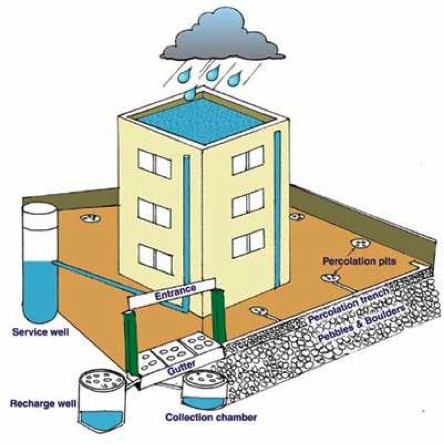Components of Rainwater Harvesting System and their Uses
Rainwater harvesting system components are used for transporting rainwater through pipes or drains, filtration and tanks for storage of harvested water.
Components of Rainwater Harvesting System
The common components of a rainwater harvesting system are:
- Cachments
- Coarse mesh
- Gutters
- Conduits
- First flush
- Filters
- Storage tanks and
- Recharge structures
1. Catchments
The surface which directly receives the rainfall and provides water to the system is called catchment area. It can be a paved area like a terrace or courtyard of a building, or an unpaved area like a lawn or open ground. A roof made of reinforced cement concrete (RCC), galvanized iron or corrugated sheets can also be used for water harvesting.

2. Coarse Mesh
It prevents the passage of debris, provided in the roof.
3. Gutters
Channels which surrounds edge of a sloping roof to collect and transport rainwater to the storage tank. Gutters can be semi – circular or rectangular and mostly made locally from plain galvanized iron sheet. Gutters need to be supported so they do not sag or fall off when loaded with water. The way in which gutters are fixed mainly depends on the construction of the house, mostly iron or timber brackets are fixed into the walls.
4. Conduits
Conduits are pipelines or drains that carry rainwater from the catchment or roof top area to the harvesting system. Commonly available conduits are made up of material like polyvinyl chloride (PVC) or galvanized iron (GI).
5. First-flushing
A first flush device is a valve which ensures flushing out of first spell of rain away from the storage tank that carries a relatively larger amount of pollutants from the air and catchment surface.
6. Filters
The filter is used to remove suspended pollutants from rainwater collected from roof top water. The Various types of filters generally used for commercial purpose are Charcoal water filter, Sand filters, Horizontal roughing filter and slow sand filter.
7. Storage facility
There are various options available for the construction of these tanks with respect to the shape, size, material of construction and the position of tank and they are: -Shape : Cylindrical, square and rectangular.
Material of construction: Reinforced cement concrete (RCC), masonry, Ferrocement etc.
Position of tank: Depending on land space availability these tanks could be constructed above ground, partly underground or fully underground. Some maintenance measures like disinfection and cleaning are required to ensure the quality of water stored in the container.
If harvested water is decided to recharge the underground aquifer/reservoir, then some of the structures mentioned below are used.
8. Recharge structures
Rainwater Harvested can also be used for charging the groundwater aquifers through suitable structures like dugwells, borewells, recharge trenches and recharge pits.
Various recharge structures are possible – some which promote the percolation of water through soil strata at shallower depth (e.g., recharge trenches, permeable pavements) whereas others conduct water to greater depths from where it joins the groundwater (e.g. recharge wells).
At many locations, existing structures like wells, pits and tanks can be modified as recharge structures, eliminating the need to construct any fresh structures.
Some of the few commonly used recharging methods are recharging of dug wells and abandoned tube wells, Settlement tank, Recharging of service tube wells, Recharge pits, Soakaways /Percolation pit , Recharge troughs, Recharge trenches, Modified injection well.
I appreciate, cause I found exactly what I was looking for. You’ve done an excellent job. I will learn a lot of new stuff right here! Best of luck for the next! Please visit my web site Gcgutters.com.au. Best Commercial Gutter Cleaners Gold Coast service provider.
ReplyDelete